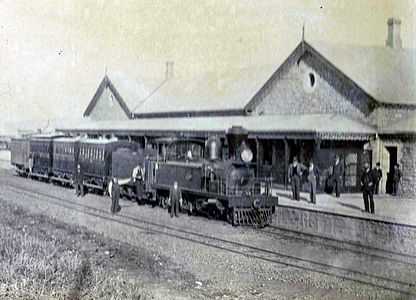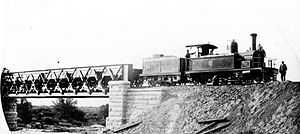CGR 2nd Class 2-6-2TT 1875
| CGR 2nd Class 2-6-2TT 1875 | |
|---|---|
|
CGR 2nd Class 2-6-2TT no. M26, with tender and "front porch railings", Fish River Bridge, c. 1881 | |
| Type and origin | |
| Power type | Steam |
| Designer | Robert Stephenson and Company |
| Builder |
Robert Stephenson and Company Avonside Engine Company Kitson and Company |
| Serial number |
RS 2205-2210, 2332-2339, 2353 engines RS 2215-2217, 2221-2223 tenders Avonside 1110-1113, 1157-1158, 1193-1194, 1209-1210 Kitson 2038-2041 |
| Build date | 1875-1879 |
| Total produced | 29 (2 lost at sea) |
| Specifications | |
| Configuration | 2-6-2T & TT "Prairie" |
| Gauge | 3 ft 6 in (1,067 mm) Cape gauge |
| Leading wheel diameter | 24 in (610 mm) |
| Driver diameter | 38 in (965 mm) |
| Trailing wheel diameter | 24 in (610 mm) |
| Wheelbase |
20 ft 3 in (6.172 m) total 8 ft (2.438 m) drivers |
| Length | 27 ft (8.230 m) over couplers |
| Height | 12 ft (3.658 m) |
| Axle load | 9 LT 6 cwt 3 qtr (9.5 t) on middle driver |
| Weight on drivers | 23 LT 17 cwt (24.2 t) |
| Locomotive weight | 28 LT 14 cwt 4 qtr (29.2 t) w/o |
| Fuel type | Coal |
| Fuel capacity |
15 long hundredweight (0.8 t) engine 2 long tons (2.0 t) tender |
| Water capacity |
650 imp gal (3,000 l; 780 US gal) engine 900 imp gal (4,100 l; 1,100 US gal) tender |
| Boiler |
10 ft (3.048 m) length inside 5 ft 10 1⁄2 in (1.791 m) pitch |
| Boiler pressure | 130 psi (900 kPa) |
| Firegrate area | 11 sq ft (1.0 m2) |
| Heating surface: – Tubes | 692 sq ft (64.289 m2) |
| – Firebox | 58 sq ft (5.4 m2) |
| – Total | 750 sq ft (70 m2) |
| Cylinders | Two |
| Cylinder size |
15 in (381 mm) bore 20 in (508 mm) stroke |
| Performance figures | |
| Tractive effort | 11,546 lbf (51 kN) at 75% pressure |
| Locomotive brake | Clarke’s chain brakes |
| Career | |
| Operator(s) | Cape Government Railways |
| Class | 2nd Class |
| Number in class | 27 |
| Delivered | 1875-1879 |
| First run | 1875 [1][2] |
The CGR 2nd Class 2-6-2TT of 1875 is a South African steam locomotive from the pre-Union era in the Cape Colony.
The first locomotives to enter service on the new 3 feet 6 inches Cape gauge mainlines of the Cape Government Railways were 2-6-2 Prairie type side-tank engines that were delivered between 1875 and 1879. Four-wheeled tenders were also acquired and the locomotives could be operated in either a tank or tank-and-tender engine configuration, as circumstances demanded. These locomotives were later designated the Cape 2nd Class.[1][2]
Cape Government Railways
In 1872 the Cape Government took over the operation of all railways in the Cape Colony and established the Cape Government Railways (CGR). Shortly before, it had been decided to adopt the narrower 3 feet 6 inches gauge instead of the existing standard gauge for all further railway expansions, since it would decrease the cost of construction through the difficult terrain inland from the three major ports at Cape Town, Port Elizabeth and East London. The 3 feet 6 inches gauge is still known as Cape gauge.[1][3]
Since the whole operational area within the Colony was so vast, the CGR was divided into three semi-autonomous systems. The Cape Eastern System was based in East London, with A.E. Schmid as Resident Engineer and J.D. Tilney as Locomotive Superintendent. The Cape Midland System was based in Port Elizabeth, with D. Jackson Scott as Resident Engineer and Mr. Edwards as Locomotive Superintendent. The Cape Western System was based in Cape Town, with W.G. Brounger as Resident Engineer as well as Consulting Engineer for the whole CGR and Michael Stephens as Locomotive Superintendent.[3]
Manufacturers
The first Cape gauge mainline locomotives to enter service on the CGR were delivered in 1875. An order for six 2-6-2T Prairie type locomotives was placed with Robert Stephenson and Company, followed by a separate order for six four-wheeled tenders. The Stephenson locomotives were numbered W1 and W2 for the Cape Western system and M7 to M10 for the Midland System.[2]
Four more locomotives were ordered from the Avonside Engine Company at the same time. Two of the Avonside locomotives went to the Midland System, numbered M5 and M6. The other two were intended for the Eastern System, but they were lost at sea during delivery when the ship Memento sank off East London on 5 February 1876.[2]
These were followed by nineteen more, all with tenders, ordered from three manufacturers.
- Four were delivered from Kitson and Company in 1876 and were numbered in the range from E17 to E20 for the Eastern system.
- Four were delivered from Avonside Engine Company in 1876 and 1878, numbered in the range from E21 to E24 for the Eastern system.
- Nine more were delivered from Robert Stephenson in 1878 and 1879, numbered in the range from M25 to M33 for the Midland system.
- The last two were delivered from Avonside Engine Company in 1879, numbered E25 and E26 for the Eastern system.[2]
When a locomotive classification system was introduced by the CGR, these locomotives became the Cape 2nd Class.[1]
Characteristics
While all the locomotives were delivered with tenders, they could be operated with or without the tenders as circumstances demanded. In practice they were used in the tank engine configuration while performing shunting or short-distance work and in the tank-and-tender configuration when an increased coal and water supply was required during mainline work.[1]
The locomotives were equipped with Clarke’s chain brakes. The braking system proved to be unsatisfactory, since breaking of the chain was not uncommon. In one instance this resulted in a bad accident with loss of life while a train was descending the Hex River rail pass.[1]
Service
One of these locomotives is known to have been named, number W1 "Byron". All of them were renumbered on occasion when the CGR altered its locomotive numbering systems circa 1886, 1888, 1890 and 1896.[1][2]
By 1904 only three of them were still in service and being employed on shunting and construction tasks. By 1912, when locomotive classification and renumbering was implemented on the newly established South African Railways, none of these 2nd Class locomotives remained in service.[2]
Works numbers and renumbering
The builders, works numbers, year built, original numbers and known renumbering of the Cape 2nd Class of 1875 are shown in the table.[1][2]
Builder |
Works no. |
Year built |
Loco no. |
1886 no. |
1888 no. |
1890 no. |
1896 no. |
1904 no. |
Notes |
|---|---|---|---|---|---|---|---|---|---|
| Avonside | 1110 | 1875 | Lost at sea | ||||||
| Avonside | 1111 | 1875 | Lost at sea | ||||||
| Avonside | 1112 | 1875 | M5 | 105 | 105 | 205 | |||
| Avonside | 1113 | 1875 | M6 | 106 | 106 | 206 | |||
| Stephenson | 2205 | 1875 | W1 | 1 | Byron | ||||
| Stephenson | 2206 | 1875 | W2 | 2 | 2 | 2 | 2 | 2 | |
| Stephenson | 2207 | 1875 | M7 | 107 | 107 | 207 | 407 | ||
| Stephenson | 2208 | 1875 | M8 | 108 | 108 | 208 | 408 | ||
| Stephenson | 2209 | 1875 | M9 | 109 | 109 | 209 | 409 | ||
| Stephenson | 2210 | 1875 | M10 | 110 | 110 | 210 | 410 | ||
| Kitson | 2038 | 1876 | E17 | 617 | 617 | 617 | 617 | ||
| Kitson | 2039 | 1876 | E18 | 618 | 618 | 618 | 618 | 618 | |
| Kitson | 2040 | 1876 | E19 | 19 | 619 | 619 | 619 | 619 | Scrapped 1911 |
| Kitson | 2041 | 1876 | E20 | 20 | 620 | 620 | 620 | ||
| Avonside | 1157 | 1876 | E21 | 21 | 621 | 621 | 621 | ||
| Avonside | 1158 | 1876 | E22 | 22 | 622 | 622 | 622 | ||
| Avonside | 1193 | 1878 | E23 | 23 | 623 | 623 | 623 | ||
| Avonside | 1194 | 1878 | E24 | 24 | 624 | 624 | 624 | ||
| Stephenson | 2332 | 1878 | M25 | 125 | 125 | 225 | |||
| Stephenson | 2333 | 1878 | M26 | 126 | 126 | 226 | |||
| Stephenson | 2334 | 1878 | M27 | 127 | 127 | 227 | |||
| Stephenson | 2335 | 1878 | M28 | 128 | 128 | 228 | |||
| Stephenson | 2336 | 1878 | M29 | 129 | 129 | 229 | |||
| Stephenson | 2337 | 1878 | M30 | 130 | 130 | 230 | |||
| Stephenson | 2338 | 1879 | M31 | 131 | 131 | 231 | |||
| Stephenson | 2339 | 1879 | M32 | 132 | 132 | 232 | |||
| Stephenson | 2353 | 1879 | M33 | Works 2352 or 2353 | |||||
| Avonside | 1209 | 1879 | E25 | 25 | 625 | 625 | 625 | ||
| Avonside | 1210 | 1879 | E26 | 26 | 626 | 626 | 626 | ||
Configurations illustrated
The photographs illustrate the locomotive in various configurations.
-
_of_1875.jpg)
CGR 2nd Class no. W2 of the Cape Western System, without tender or "front porch railings", c. 1899
-

With tender, balloon chimney and "front porch railings", Grahamstown Station, c. 1880
See also
- CGR 2nd Class 4-4-0T 1882
- List of South African locomotive classes
- South African locomotive history
- The 2-6-2 "Prairie"
References
|
- ↑ 1.0 1.1 1.2 1.3 1.4 1.5 1.6 1.7 Holland, D.F. (1971). Steam Locomotives of the South African Railways, Volume 1: 1859-1910 (1st ed.). Newton Abbott, Devon: David & Charles. pp. 23–25. ISBN 978-0-7153-5382-0.
- ↑ 2.0 2.1 2.2 2.3 2.4 2.5 2.6 2.7 C.G.R. Numbering Revised, Article by Dave Littley, SA Rail May–June 1993, pp. 94-95.
- ↑ 3.0 3.1 The South African Railways - Historical Survey. Editor George Hart, Publisher Bill Hart, Sponsored by Dorbyl Ltd., Published c. 1978, pp. 4, 8, 11.
